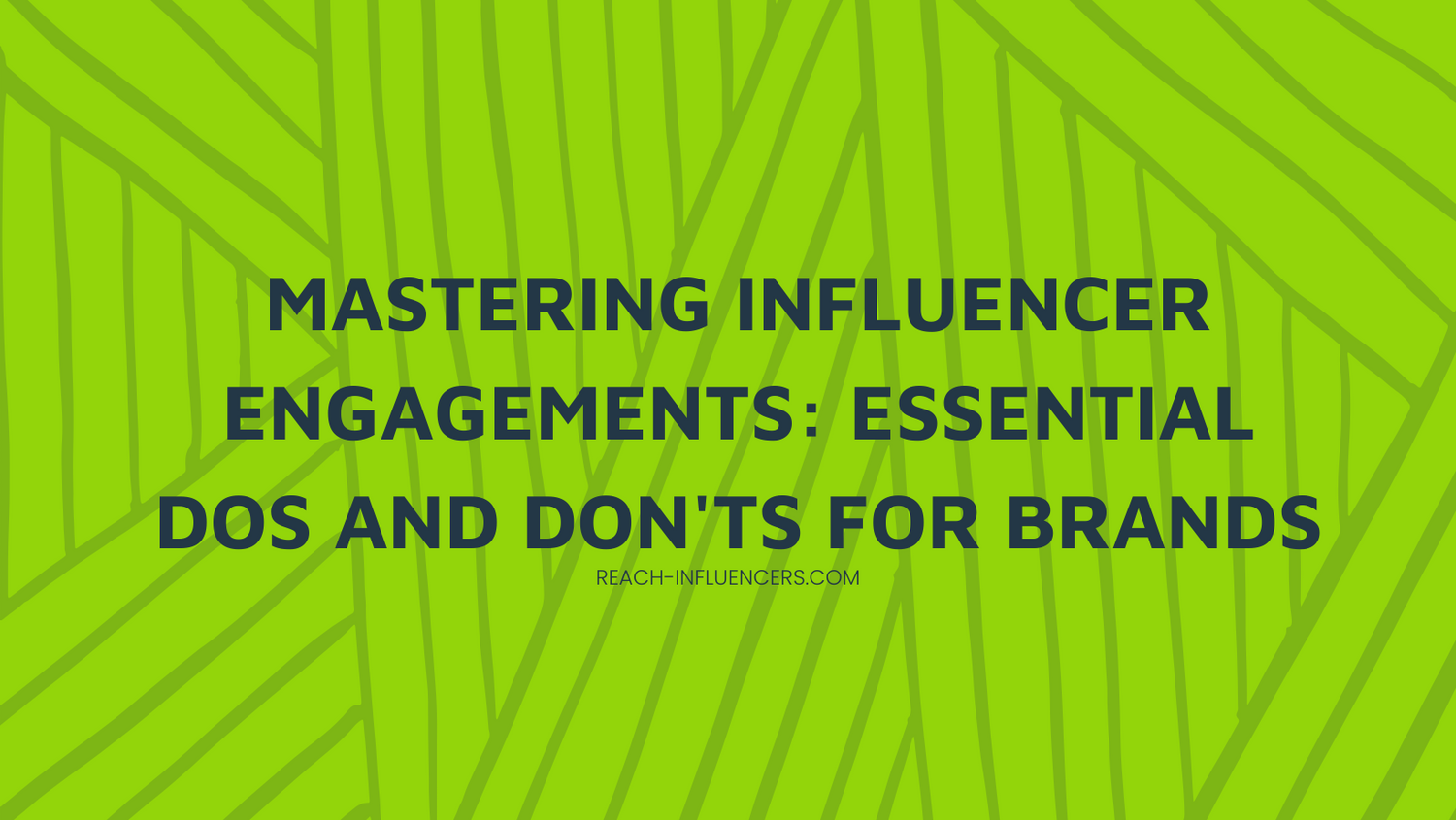Influencer partnerships have become an essential component of successful marketing strategies. However, it takes careful planning and execution when it comes to mastering influencer engagements. This guide highlights the dos and don’ts that brands should consider when collaborating with influencers. By following these guidelines, brands can ensure that their partnerships with influencers are mutually beneficial and result in impactful campaigns.
Dos:
Thorough Research and Alignment: When reaching out to potential influencers, it’s important to conduct thorough research beforehand. Doing your research will ensure that an influencer’s content, audience demographics, and values align closely with your brand’s identity and target customer. This will not only help you to establish a strong and lasting relationship with the influencer but also ensure that your brand’s message is effectively communicated to the right audience.
Personalized Outreach: Personalized outreach in influencer marketing entails crafting tailored messages that genuinely understand the influencer’s content, values, and audience. This involves building authentic relationships, aligning with the influencer’s values, and highlighting relevance to their audience demographics. Additionally, it includes standing out in a crowded space, demonstrating professionalism, and customizing collaboration proposals based on the influencer’s strengths and interests.
Transparent Communication: Transparent communication is a fundamental aspect of successful influencer marketing collaborations. To build a solid foundation for a partnership, it is essential to establish clear expectations, outline compensation terms, and define campaign objectives right from the outset. This level of transparency not only fosters trust between the brand and the influencer but also ensures a smooth and mutually beneficial collaboration. For instance, communicating the scope of work, deliverables, and any specific requirements allows influencers to align their creative efforts with the brand’s goals.
Empower Creative Freedom: Empowering creative freedom is a key principle in influencer marketing, emphasizing the importance of trusting the influencer’s creative instincts. While it’s essential to engage in discussions about campaign ideas and objectives, granting influencers the autonomy to express their creativity is equally vital. This trust not only fosters authenticity but also enables influencers to craft content that genuinely resonates with their audience. A notable real-world example is the collaboration between Nike and the popular fitness influencer, Chloe Ting. Nike recognized Chloe Ting’s authentic fitness journey and engaged her to promote their activewear line. Instead of dictating specific poses or scripts, Nike trusted Chloe’s creative instincts, allowing her to integrate the brand seamlessly into her workout routines and daily fitness content. This approach not only enhanced Nike’s brand image but also contributed to increased credibility and trust among Chloe Ting’s followers, illustrating the success of empowering creative freedom in influencer collaborations.
Cultivate Long-Term Relationships: Long-term influencer partnerships are advantageous as they foster authenticity and trust. Sustained collaborations allow influencers to deeply understand a brand, resulting in genuine endorsements that resonate with their audience. Consistency in brand representation enhances recall, while cost efficiency is achieved by leveraging initial investments. Influencers evolving into brand ambassadors further amplify promotional efforts, making long-term partnerships a strategic and beneficial choice in influencer marketing.
Don’ts:
Follower Count Over Relevance: It is essential to avoid fixating solely on an influencer’s follower count when seeking collaborations. While a large following may seem impressive, audience relevance and engagement metrics are paramount for the success of partnerships. For instance, a niche lifestyle influencer with a smaller but highly engaged audience can deliver more impactful results for a brand targeting a specific demographic than a high-follower-count influencer with a less engaged audience.
Over-Controlling Content: Excessive interference in content creation hinders the authenticity that makes influencer marketing effective. Influencers thrive when they maintain their unique voice and style. A prime example is the partnership between Dove and beauty influencer Shalom Blac. By allowing Shalom creative freedom, Dove benefited from authentic content that resonated with her audience and showcased the brand in a way that felt genuine rather than overly controlled.
Lack of Formal Agreements: Proceeding without a formal agreement is a common pitfall that can lead to misunderstandings. Clear contracts detailing deliverables, timelines, usage rights, and compensation terms are crucial for the success of influencer marketing campaigns. A real-world illustration is the collaboration between Gymshark and fitness influencer Whitney Simmons, where a comprehensive agreement ensured both parties were aligned on expectations, resulting in a successful and mutually beneficial partnership.
Compromising Authenticity: Pushing overtly promotional content risks compromising authenticity, a quality that resonates more with audiences than overly branded or sales-driven posts. An example is the collaboration between GoPro and adventure influencer Alex Chacón. By allowing Alex to naturally integrate GoPro into his travel content, the brand benefited from authentic, visually stunning narratives that felt genuine to his audience, enhancing the impact of the collaboration.
Neglecting Feedback and Follow-Up: Concluding collaborations without proper follow-up is a missed opportunity for improvement. Gathering feedback from influencers is vital for refining future partnerships and campaigns. For instance, after a campaign with a tech influencer, a brand might learn valuable insights about audience preferences and adjust future collaborations accordingly, creating a more effective and tailored approach.
Conclusion:
Influencer engagements, when executed thoughtfully, can yield tremendous benefits for brands, including increased reach, credibility, and engagement. By adhering to these dos and steering clear of the don’ts, brands can navigate influencer partnerships successfully, fostering meaningful connections with audiences and driving impactful marketing campaigns. Remember, the key lies in establishing authentic, mutually beneficial relationships that resonate with both the influencer and the brand’s audience.
With a platform like Reach, you can easily manage and scale your influencer campaigns to get the most out of your budget and time. Sign up today or set up a demo to learn more!



Leave A Comment